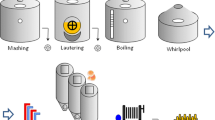Abstract
This study was performed to investigate the quality characteristics of distilled spirits made with different fermenting agents in copper distiller. The highest distillate yield was observed in the mashing made with fermenting agent A. The distillate made with fermenting agent A showed also significantly the highest level of ester and higher-alcohol concentration. In addition, the distilled spirit made with fermenting agent A indicated significantly higher preferences in appearance, smell, taste, quality, and overall acceptability than those of other agents. However, the aging in bottle for 6 months had no significant differences in sensory improvement in distilled spirits regardless in kind of fermenting agents. This study emphasizes the importance of rice koji as fermenting agent in distilled spirit prepared with rice and using with multistage distiller made of copper to improve aroma substances and yield ratio of distillate.








Similar content being viewed by others
References
Arctander S (1969) Perfume and flavor chemicals I. Allured Publishing Corporation, Montclair
Bae SM, Jong SY, Jung IS, Ko HJ, Kim TY (2003) Effect of the amount of water on the yield and flavor of Korean distilled liquor based on rice and corn starch. J East Asian Soc Diet Life 13:439–446
Bae KW, Ryu HY, Kwan IS, Kwon CS, Sohn HY (2007a) Optimization of thickness and maturation period of Andong soju nuruk for fermentation of Andong soju. Korean J Microbiol Biotechnol 35:231–237
Bae KH, Shin KS, Ryu HY, Kwon CS, Sohn HY (2007b) Identification and fermentation characteristics of lactic acid bacteria from the fermentation broth of Korean traditional liquor, Andong soju. Korean J Microbiol Biotechnol 35:310–315
Cho HC, Kang SA, Choi SI, Cheong C (2013) Quality characteristics of fruit spirits from a copper distillation apparatus. J Korean Soc Food Sci Nutr 42:743–752
Choi SI, Kang SA, Cheong C (2013) Yeast selection for quality optimization of distilled spirits. J Korea Acad-Ind Coop Soc 14:3887–3896
In HY, Lee TS, Lee DS, Noh BS (1995a) Quality characteristics of soju mashes brewed by Korean traditional method. Korean J Food Sci Technol 27:134–140
In HY, Lee TS, Lee DS, Noh BS (1995b) Volatile components and fusel oils of sojues and mashes brewed by Korean traditional method. Korean J Food Sci Technol 27:235–240
Jee JH, Lee HS, Lee JW, Suh DS, Kim HS, Kim KO (2008) Sensory characteristics and consumer liking of commercial sojues marketed in Korea. Korean J Food Sci Technol 40:160–165
Kim HR, Ahn BH (2001) Research trend of Korean traditional alcoholic beverage. Food Ind Nutr 6:5–10
Kim YS, Kang SH, Jung JH (1991a) Studies on the processing of Korean traditional soju, Jindo Hongju I. Changes in components of Hongju mash fermented by different methods. Korean J Diet Cult 6:245–247
Kim YS, Kang SH, Jung JH (1991b) Studies on the processing of Korean traditional soju, Jindo Hongju II. Composition and sensory evaluation of Hongju. Korean J Diet Cult 6:251–255
Kim HR, Kim JH, Bae DH, Ahn BH (2010) Charaterization of yakju brewed from glutinous rice and wild type yeast strains isolated from nuruks. J Microbiol Biotechnol 20:1702–1710
Lee KH (1989) Sale trend and manufacturing of distilled spirit. Korean J Diet Cult 4:301–309
Lee DS, Park HS, Kim PK, Lee TS, Noh BS (1994a) Determination and multivarate analysis of flavor components in the Korean folk sojues using GC-MS. Korean J Food Sci Technol 26:750–758
Lee DS, Park HS, Kim K, Lee TS, Noh BS (1994b) Physicochemical characteristics of Korean folk sojues. Korean J Food Sci Technol 26:649–654
Lee SJ, Lee JE, Kim HW, Kim SS, Koh KH (2006) Development of Korean red wines using Vitis labrusca varieties: instrumental and sensory characterization. Food Chem 94:385–393
Lee HS, Park CS, Choi JY (2010) Quality characteristics of the mashes of Takju prepared using different yeasts. Korean J Food Technol 42:56–62
Lee SJ, Park CS, Kim HK (2012) Sensory profiling of commercial Korean distilled soju. Korean J Food Sci Technol 44:648–652
Lee YH, Eom T, Cheong C, Cho HC, Kim IY, Lee YS, Kim MS, Yu SY, Jeong YH (2013) Quality characteristics of spirits by different distillation and filtration. J Korean Soc Food Sci Nutr 42:2012–2018
Min YK, Yun HS, Jeong HS, Jang YS (1992) Changes in compositions of liquor fraction distilled from Samil ju with various conditions. Korean J Food Sci Technol 24:440–446
Min YG, Yoon HS, Jung HS (1994) A study of distillation operation in Baikhaju. Agric Chem Biotechnol 37:9–13
Park JS, Chung BW, Bae JO, Lee JH, Jung MY, Choi DS (2010) Effects of sweet potato cultivars and koji types on general properties and volatile flavor components in sweet potato soju. Korean J Food Sci Technol 42:468–474
Ryu LH, Kim YM (2002) Esterification of alcohols with organic acids during distilled spirit distillation. Korean J Food Nutr 15:295–299
Son HS, Park BD, Ko BK, Lee CH (2011) Quality characteristics of Takju produced by adding different amounts of water. Korean J Food Technol 43:453–457
Yoo KS, Kim J, Seo EY, Kim YJ, Choi HY, Yoon HS, Kim MD, Han NS (2010) Improvement in sensory characteristics of Cambell Early wine by adding dual starters of Saccharomyces cerevisiae and Oenococcus oeni. J Microbiol Biotechnol 20:1121–1127
Author information
Authors and Affiliations
Corresponding author
Rights and permissions
About this article
Cite this article
Lee, JW., Kang, SA. & Cheong, C. Quality characteristics of distilled alcohols prepared with different fermenting agents. J Korean Soc Appl Biol Chem 58, 275–283 (2015). https://doi.org/10.1007/s13765-015-0028-8
Received:
Accepted:
Published:
Issue Date:
DOI: https://doi.org/10.1007/s13765-015-0028-8



